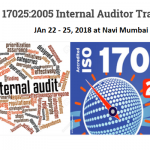Clause no 6.2.2 of the ISO 9001: 2008 standard specifies the following requirement
Clause no 6.2.2 of the ISO 9001: 2008 standard specifies the following requirement:-
“The organization shall
a) determine the necessary competence for personnel performing work affecting conformity to product
requirements,
b) where applicable, provide training or take other actions to achieve the necessary competence”
In order to meet this requirement, the organizations must understand what is the meaning of the word “competence” and how to carry out competence evaluation.
Competency is defined as an individual’s set of skills and abilities that are measurable and observable. These are categorized into three: functional, managerial, and behavioral. It could be a cumulative effect of characteristics, knowledge, skills, and capabilities that, when utilized, would result to an effectual performance. It is a means by which businesses and organizations can work towards their goals. In addition, as a rule of thumb, they should be able to identify the various competencies of their employees, from upper management to the front liners.
Competencies include the collection of success factors necessary for achieving important results in a specific job or work role in a particular organization. Success factors are combinations of knowledge, skills, and attributes (more historically called “KSA’s”) that are described in terms of specific behaviors, and are demonstrated by superior performers in those jobs or work roles. Attributes include: personal characteristics, traits, motives, values or ways of thinking that impact an individual’s behavior.
Competenceis a standardized requirement for an individual to properly perform a specific job. It encompasses a combination of knowledge, skills and behavior utilized to improve performance. More generally, competence is the state or quality of being adequately or well qualified, having the ability to perform a specific role.
The competencies have five characteristics, namely:
* Motives: Things a person consistently thinks about or wants that cause action, motives drive, direct and select behavior towards certain actions. Example achievement motivation people consistently set challenging goals for themselves, take responsibility for accomplishing them and use the feedback to do better
* Traits: Physical characteristics and consistent responses to situations. Good eyesight is physical traits of a pilot. Emotional Self Control and initiative are more complex consistent responses to situations.
* Self Concept: A person’s attitude value or self image. A person’s values are reactive or respondent motives that predict what a person would do in the short run. Example: A person who values being a leader would be more likely to exhibit leadership behavior.
* Knowledge (Information a person has in a specific work area) Example: An accountant’s knowledge of various accounting procedures.
* Skill (is the ability to perform certain mental or physical tasks) Example: Mental competency includes analytical thinking. The ability to establish cause and affect relationship.
COMPETENCY MAPPING
Competency mapping is a process through which one assesses and determines one’s strengths as an individual worker and in some cases, as part of an organization. It generally examines two areas: emotional intelligence or emotional quotient (EQ), and strengths of the individual in areas like team structure, leadership, and decision-making. Large organizations frequently employ some form of competency mapping to understand how to most effectively employ the competencies of strengths of workers. They may also use competency mapping to analyze the combination of strengths in different workers to produce the most effective teams and the highest quality work.
What is a Competency Matrix?
A competency matrix is a tool by which a person’s competencies are assessed. It is used as a means to define the required competencies for a particular position, as well as a tool to help identify the most suitable individuals for the job. As mentioned, it is categorized into three, which are: functional, managerial, and behavioral.
Functional: This refers to the technical competencies or the hard skills that a professional would need in order for him to perform his job. This varies of course, depending on the job. For example, an IT professional should be skilled at Java Development and PHP programming; a management accountant should be good at economics, corporate finance, and financial management.
Managerial: This refers to one’s ability to work productively with other people. This can be classified into: organizational, people-related, and role-related. This includes several aspects such as, time management, staff developing, decision-making, delegation, communication, and resource management.
Behavioral: This refers to the interpersonal and “people” skills of an individual. This is where a person’s soft skills are categorized. Such skills include leadership, teamwork, motivation, adaptability, communication, service-oriented, initiative, and dynamism, among others.
How to Make a Competency Matrix
A competency matrix may be customized depending on the kind of organization or business you are in. But these are the general guidelines:
1. Develop a list of all the required competences you need in order for your organization to run successfully. Of course, these have to be aligned with your organization’s objectives, vision, mission, as well as strategies.
2. Based on your list of competencies, classify them as to the following: functional, managerial, and technical. Once you have done this, identify the level of proficiency. This can be in the following format:
- Beginner
- Learner
- Skilled
- Expert
Define these proficiency levels based on your organization’s requirements.
3. Then, as soon as you have the categories and levels of proficiency identified, determine the proficiency level of each competency required for a particular job position. This should be done for all positions in your organization, and this process is otherwise referred to as competency mapping.
Competency mapping is a process that is used alongside the competency matrix. In essence, the matrix is the tool and the mapping is the process. Once you are able to identify the level of competencies of each individual, you can then pinpoint which of these competencies are required to perform successfully a job or a role.







